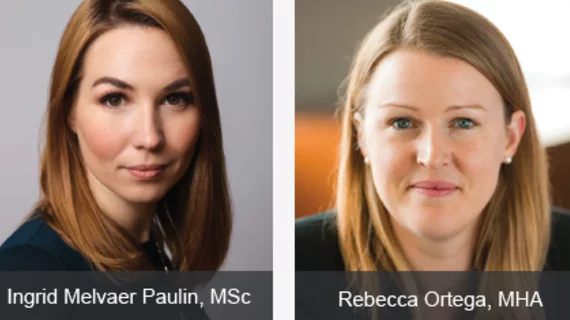Taking Small Steps to Address Gender Bias in Cardiology
Look to behavioral science for new solutions that could reduce gender bias in medicine.
In a JAMA Cardiology viewpoint article, Roxana Mehran, MD, of the Icahn School of Medicine at Mount Sinai in New York City, described her outrage when a fellow, speaking at the Transcatheter Cardiovascular Therapeutics (TCT) 2017 annual conference, recalled job interviewers asking about her intentions to have children.
“I could not believe this,” Mehran wrote. “I thought, “Am I in an alternate universe? Is this 2017, or am I back in 1995, when I was asked the very same question at my own job interview?” (JAMA Cardiol, online May 30, 2018).
Citing findings from two American College of Cardiology surveys, Mehran lamented that almost half of female cardiologists report having been asked in interviews whether they are planning to have children and that more than 60 percent say they have experienced sex-based discrimination (J Am Coll Cardiol 2017;69[4]:452-62; 2017;69[1]:92-101). Findings like these plus the perception of an unfriendly work environment and a lack of role models in the field have compounded to suggest a clear and troubling pattern: Cardiology may be losing out on female talent due to discriminatory practices.
Biases in organizations may seem intimidating to address, but doing so is necessary to attract and retain some of the best talent. Large steps, like changes in legislation and institutional policies, are necessary, but they don’t address the whole problem and can take a long time to put in place. Meanwhile, organizations should consider smaller steps they can take to mitigate bias. Many of these small steps are suggested by research in behavioral science, which shows that seemingly small changes can make a big difference.
Look beyond “debiasing”
It can be tempting to look for solutions that claim to “debias” people, but implicit bias trainings claiming to be a quick fix are unlikely to work. Nevertheless, it can be useful to learn what implicit bias is, and diversity trainings can signal the values of an organization as well as start important conversations about culture. Trainings are small (often first) steps, and positive effects are more likely to be seen if they are part of a larger initiative. Duke University’s Medical Professionalism Project, for example, is a film-based course that explores a variety of topics around medical professionalism through the lens of behavioral science. Designed with the option to engage with the material throughout the year, the program makes it easier for healthcare professionals to regularly think about how biases influence their everyday decisions and how to encourage professionalism in organizations.
Strive to be “good-ish”
The idea of mindsets is not new in healthcare, as they can serve to guide our attention and motivation. Consider the placebo effect: If a patient is convinced that a medication will work, it is more likely to have an effect. Many clinicians work to influence their patients’ mindset-related challenges such as medication adherence and capacity for change.
Our social environments profoundly influence mindsets, which is why institutions can and should fight gender bias by encouraging a different mindset. In her book The Person You Mean to Be, New York University social psychologist Dolly Chugh contends that being “good-ish” can be better than being good (HarperCollins, 2018).
When we think about people or organizations as inherently good or bad, there is little room for growth. (If you consider your behavior innate, it’s hard to see it as changeable. It’s who you are, not an action you took.) However, if we see ourselves as “good-ish,” acknowledging we sometimes make good choices and sometimes make poor ones, we adapt a growth mindset that can help us strive to be better than we are. Instead of seeing our traits and abilities as fixed, we begin to believe that we can change them if we just work on it.
Reduce discretion
Implicit bias is most influential in situations with uncertainty and ambiguity. When physicians or hiring managers have a lot of discretion in their decision making, it can lead to situations where they unintentionally rely on their implicit biases to make decisions. Reducing discretion helps make the desired behavior more apparent, and less ambiguity can help shrink disparities.
To increase representation of women in cardiology, we should examine the processes where high discretion can lead to gender bias. That typically includes decisions not only about hiring, promotion and performance evaluations but also who gets assigned to different tasks, schedules and committees.
Of her experience at TCT.17, Mehran wrote that the panel was shocked silent. After a moment, some began rationalizing that the questions related to childbearing were likely intended to consider coverage for the program. While addressing bias in organizations or fields such as cardiology is a long process, rationalizing won’t get us to where we need to be. Doing so ignores both the experiences of those who live with the consequences of bias and the fact that we are not always rational creatures. Bias in medicine is a trenchant problem, which means we need new solutions; behavioral science can offer some. To combat bias, we need to recognize the ways that biases influence our behavior and take steps, both big and small, to address them.
Ingrid Melvaer Paulin, MSc, is part of the team at Duke University’s Center for Advanced Hindsight, where she works on applying insights from behavioral economics to the design of products and services that improve people’s health, wealth and happiness. Rebecca Ortega, MHA, is with the Center for Interventional Cardiovascular Research and Clinical Trials at the Icahn School of Medicine at Mount Sinai and is a co-founder of the nonprofit organization Women as One.

